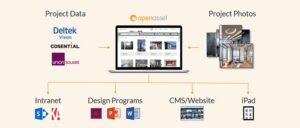AI In Construction
Jun 26, 2018

Artificial Intelligence (AI) is a huge digital innovation that is creating amazing opportunities for businesses. In short, AI is the process of creating intelligent machines. The machines are ultimately computers, but they are able to carry out tasks that are usually done by people.
The human or intelligent aspect comes in as they are able to recognise speech, to learn and to problem solve. To enable them to take their intelligence to this level they need to have access to a lot of information. To use this information they need to implement knowledge engineering, allowing them to assimilate the information in a meaningful way. With knowledge engineering, computers are able to observe the world around them, understand data that they collect and act independently to put the data to the best use.
Many industries have already started using AI technologies to automate processes such as information capture and data processing. The technology offers a huge step forward in efficiency as computers are able to do the time-consuming day-to-day tasks while people can focus on their skill sets and deal with more complicated issues that aren’t so easily automated. Companies are able to work smarter and more efficiently, harnessing the power of the information and data that they gather and using data as the key driver in decision making. The symbiosis between man and machine forms a bit part of the ways businesses are evolving and digitally transforming.
The future potential of AI is quite incredible. It has the means to do so much more than save time and make processes more efficient. With the aforementioned knowledge engineering, it has the capabilities to convert raw data and communications into meaningful and profitable customer relationships. Moving forward AI will be able to make decisions that will improve outcomes for customers and businesses alike.
How AI is forming the future of AEC and Real Estate firms
Data is at the heart of a successful AI strategy and increasingly, AEC and Real Estate firms have begun to adjust the way they collect, store and process data. Industry-wide sharing of big data is leading to increased collaboration between teams and the breaking down of silo structures within organizations. However, data use within the AEC and Real Estate industries remains largely unregulated, requiring a degree of consensus about best practices and necessitating increased investment in and awareness of cyber-security. There is also a growing understanding that as the buildings become increasingly embedded with technology, data such as energy consumption and maintenance information can be accessed and perceived directly in the built environment, instead of living in spreadsheets.
How Is AI Changing The Construction Industry
The construction industry is currently a relatively small market for AI. However, it has potential to help the industry address many issues and will become increasingly prevalent. Construction sites are generally considered one of the most dangerous workplace settings. AI has the potential to go along way towards addressing these risks and inefficiencies. The construction industry is also tackling a skill shortage and AI technology can offer time-saving solutions and improved productivity to help solve this, not to mention the development of autonomous machines.
At the current time, AI is being used at a reasonably low level within the construction industry. Alerts are created using field reporting software to allow supervisors to communicate quickly and effectively with project and safety managers. These also enable stakeholders to be updated in real time. Meanwhile, optical character recognition is used to process drawings to allow them to be easily searchable and convertible, this saves many hours of manual processing. The future of AI for the construction industry is really exciting with the following technologies under development and early adoption in some firms:
- Planning and design – 3D modelling using AI technology enables construction professionals to efficiently plan, design, construct and manage buildings and infrastructure.
- Safety and efficiency – machine learning enables high-risk issues to be predicted and prioritized. Photo and video data can be translated into actionable insights. Problems are flagged and training improved accordingly.
- Photo and video creation – management platforms are being developed to tag videos and photos upon creation using machine learning, speech and image recognition.
- Autonomous equipment – construction machinery is being developed to be able to perceive their surroundings and other machinery. Construction professionals will be able to work with 3D visualizations of entire construction sites in real time to increase on-site safety.
The use of technology such as autonomous machinery comes with concerns over safety in its infancy and loss of jobs within the industry in the long term. However, the foreseeable future will more than likely result in a more symbiotic relationship where there will still be a requirement for humans to oversee machines to ensure they are working efficiently and maintaining safety standards. The near future will see data-gathering equipment on heavy equipment and drone-based terrain visualisations of the job site. This should enable operators to make informed decisions with a higher level of awareness about their surroundings. This also allows for construction equipment to be monitored more closely and to thereby improve efficiency.
Enhancing safety in construction sites using AI is starting to be adopted by the larger firms. The following years will see the development of these technologies to enable AI to be embedded into the whole construction process from planning to completion.





